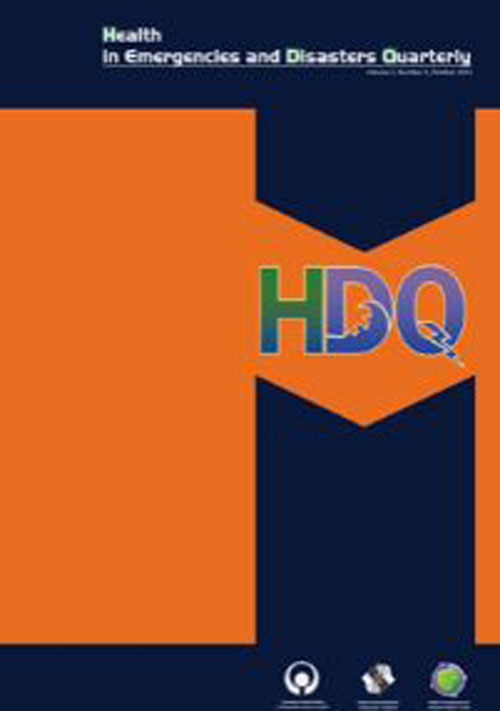فهرست مطالب

Health in Emergencies and Disasters Quarterly
Volume:7 Issue: 2, Winter 2022
- Special Issue on Covid-19
- تاریخ انتشار: 1401/01/29
- تعداد عناوین: 6
-
-
Pages 59-61
-
Pages 63-70Background
Prehospital emergency staff usually encounter patients in situations that can affect the mental health of the medical staff and cause symptoms of depression, anxiety, and stress. This study aimed to determine depression, anxiety, and stress in prehospital emergency personnel during the COVID-19 epidemic in Ardabil City, Iran, 2020.
Materials and MethodsA descriptive cross-sectional study was conducted from March 2020 to April 2020 with the participation of 138 working staff in the prehospital emergency department of Ardabil City. The samples were selected by the census method. Necessary information was collected with a two-part questionnaire: a demographic questionnaire and the DASS-21 standard questionnaire. DASS-21 is a 21-item questionnaire that consists of three subscales of 7 questions: depression, anxiety, and stress. The obtained data were analyzed using descriptive statistics, including mean and standard deviation, and inferential analysis, including analysis of variance, independent t test, and multiple regression using SPSS software v. 22 statistical software.
ResultsThe results showed that 45.7% of the staff had moderate depression, 44.9% moderate anxiety, and 77.5% normal stress. There was a significant relationship between work experience and stress level (P=0.03). There were significant associations between age with depression (P=0.04), anxiety (P=0.00) and stress (P=0.01). There was also a significant relationship between gender and variables of stress (P=0.00) and anxiety (P=0.01). Multiple regression results showed that gender and education variables are predictors of anxiety and stress, and age and education variables are predictors of depression (P<0.05).
ConclusionMore than half of the staff had moderate to severe depression and anxiety. Considering that prehospital emergency personnel has a vital role in improving and promoting people’s health in the community, eliminating the underlying factors that cause emotional reactions in them is considered a health priority.
Keywords: Depression, Anxiety, Stress, Prehospital emergency, COVID-19 -
Pages 71-78Background
Hospitals, as the most important medical institutions, must be adequately prepared before accidents to cope with emergencies and provide rapid response to disasters. This study aimed to determine the preparedness of hospitals in Ardabil Province during the COVID-19 pandemic.
Materials and MethodsThe present study is a cross-sectional study, and the study population included all hospitals in Ardabil Province, Iran (17 hospitals in total). The data collection tool was a standard checklist of 92 questions for COVID-19 Crisis Preparedness issued by the Iran Ministry of Health and Medical Education. The obtained data were analyzed using descriptive and inferential statistics (the Pearson correlation analysis) in SPSS software v. 22.
ResultsThe mean relative score of preparation for the COVID-19 pandemic was 80.27% among the hospitals in the province. In the studied hospitals, the relative scores of preparedness were as follows: leadership and coordination, 92.64%, resource management, 94.36%; information management, 79.90%; communications, 77.94%; human resources, 77.69%; surge-capacity, 86.55%; rapid identification, 57.18%; diagnosis, 71.32%; isolation and patient management, 81.09%; and infection prevention and control, 84.05%.
ConclusionThe level of hospital preparedness in most dimensions (9 out of 10 dimensions) was good, and only in the area of rapid identification was at a moderate level. However, further evaluation is needed at different stages of an epidemic.
Keywords: Preparedness, Hospital, Pandemic, COVID-19 -
Pages 79-86Background
Rapid transmission and sudden outbreak of new coronavirus have caused widespread stress among the community and treatment staff. Regarding the consecutive peaks of the disease, its persistence stress, in the long run, creates destructive effects and leads to physical weakness and psychological complications. Hence, the present study seeks to find proper ways to promote psychological capital and reduce the stress of contracting COVID-19 with the mediating role of empathy.
Materials and MethodsThe present research was an applied and analytical study. It is a cross-sectional study conducted in 2020. The study’s statistical population comprised 510 nurses working in Tehran Oil Industry Hospital. Using a simple random sampling method and Krejcie and Morgan table, a sample of 160 was selected. The data collection tool was a standard questionnaire whose validity and reliability have been confirmed. For data analysis, we used the structural equation modeling method and the Pearson correlation test to examine the relationship between variables.
ResultsThe findings showed the significant and direct effect of psychological capital on empathy and a significant inverse impact of both empathy and psychological capital on the stress of contracting COVID-19 in nurses. The mediating role of empathy in the relationship between psychological capital and contracting COVID-19 stress was also confirmed.
ConclusionAccordingly, by promoting the components of psychological capital in nurses, the hospital managers can prepare them for daily stress during the coronavirus epidemic. Also, by strengthening the empathy indicators in employees along with psychological capital, the tensions related to this disease can be overcome more than ever.
Keywords: Psychological capital, Stress of contracting COVID-19, Empathy, Oil industry hospital -
Pages 87-95Background
According to the World Health Organization, preventive measures are the only non-pharmacological method to combat the COVID-19 epidemic. This study aimed to investigate the relationship between perceived social support and preventive behaviors mediated by the variables of life expectancy and mental wellbeing.
Materials and MethodsThis study is applied in terms of purpose and was conducted by survey method. The statistical population included women living in Tehran City, Iran, with a sample size of 428. The study data were collected using the preventive behavior scale, mental wellbeing scale, Snyder hope scale, and multidimensional perceived social support scale. The obtained data were analyzed using SPSS 25 and AMOS 23 software.
ResultsThe study results showed a positive and significant relationship between perceived social support and mental wellbeing, between perceived social support and life expectancy, and between mental wellbeing and life expectancy. Also, life expectancy and mental wellbeing variables mediate between perceived social support and preventive behaviors.
ConclusionConsidering the critical role of women in family management and preventive measures during the COVID-19 epidemic, strengthening social support networks, hope, and mental wellbeing should be considered.
Keywords: Social support, Preventive behaviors, Life expectancy, Mental wellbeing, Women, COVID-19

